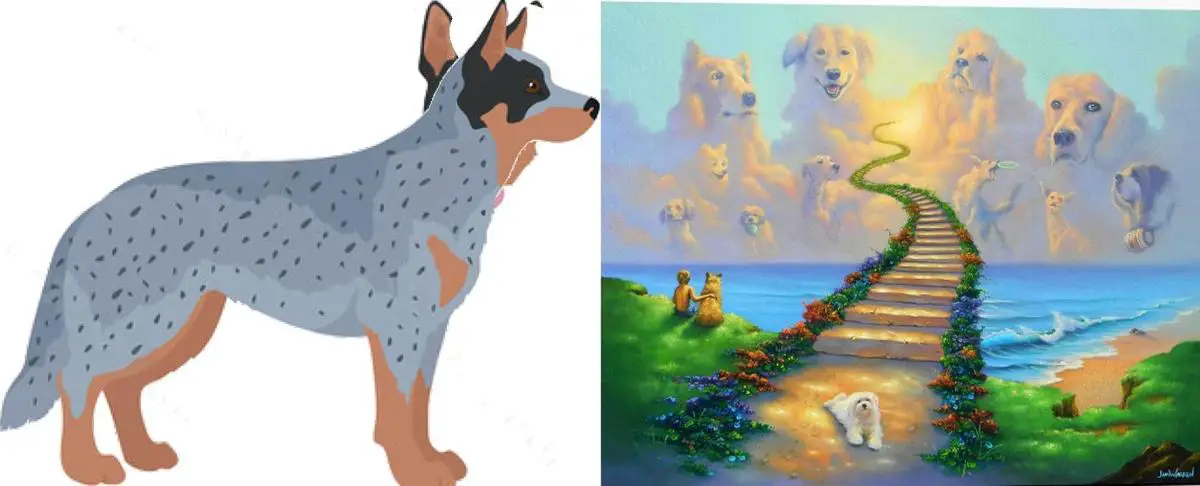Quick Links: Table of Contents
- How Long Australian Cattle Dogs Live. Australian Cattle Dog Life Expectancy
- Lifespan of the Australian Cattle Dog Compared to Other Dog Breeds
- Common Causes of Death in Australian Cattle Dog, and how to Prevent Them.
- How To Prevent Genetic Problems in Australian Cattle Dogs
- How Old is Your Australian Cattle Dog in Human Years
- How Long Do Australian Cattle Dogs Live in Human Years?
- More Ways to Make Your Australian Cattle Dog Live Long
- Conclusion on Australian Cattle Dog Life Expectancy
How Long Australian Cattle Dogs Live. Australian Cattle Dog Life Expectancy
Generally, the lifespan of the Australian Cattle Dog is from 12 to 15 years.
Moreover, a few years back, British Veterinarinan researchers performed a scientific study to determine the lifespan of the Australian Cattle Dog. In this study, the scientists collected data on how long 11 pet Australian Cattle Dogs lived.
From the study, it was found that Australian Cattle Dogs have a average lifespan of 11.6 years. Furthermore, the study found that Australian Cattle Dogs can live for as long as 15.9 years.
Furthermore, researchers from the University of Georgia conducted a study to find out what are the top causes of death in Australian Cattle Dogs.
According to the study, the top 5 causes of death in Australian Cattle Dogs are:
- Trauma: Issues involving injury
- Neoplastic Disease: Issues involving tumors
- Infectious Disease: Problem caused by bacteria, viruses, parasites, or fungi.
- Musculoskeletal Disease: Refers to any problems with bones or muscles
- Neurologic Disease: Refers to problems with the brain, nerves, and spinal cord.
In this article, we will explain each of these diseases and discuss how to prevent the early occurence of each in your Australian Cattle Dog to make your Australian Cattle Dog live a longer.
Also, in this article, we will discuss other things you can do to ensure that your Australian Cattle Dog have a longer than average lifespan.
Do you want to know how old your Australian Cattle Dog is in human years? Then, check out our Australian Cattle Dog age to human years calculator
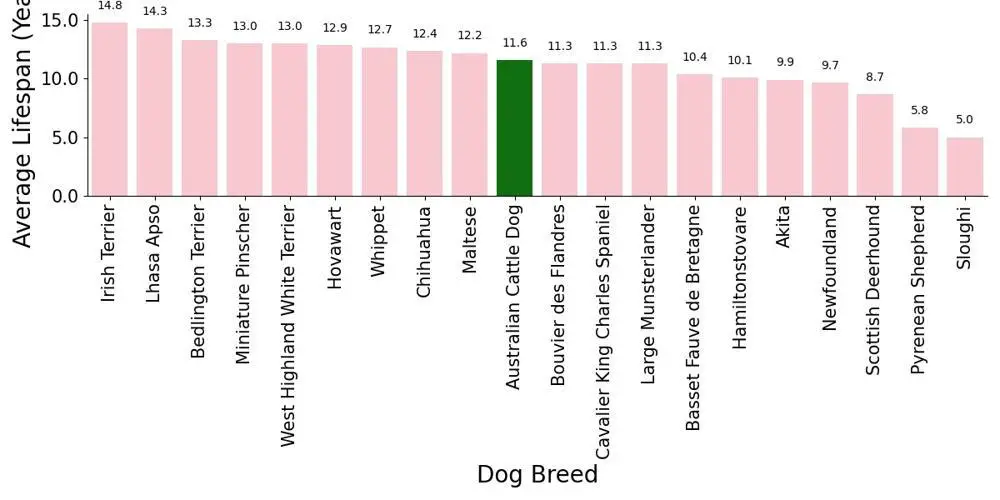
Lifespan of the Australian Cattle Dog Compared to Other Dog Breeds
See in the table below how the lifespan of the Australian Cattle Dog compares to the lifespan of other dog breeds.
| Dog Breed | Average Lifespan (Years) |
|---|---|
| Irish Terrier Lifespan | 14.80 |
| Lhasa Apso Lifespan | 14.30 |
| Bedlington Terrier Lifespan | 13.30 |
| Miniature Pinscher Lifespan | 13.00 |
| West Highland White Terrier Lifespan | 13.00 |
| Hovawart Lifespan | 12.90 |
| Whippet Lifespan | 12.70 |
| Chihuahua Lifespan | 12.40 |
| Maltese Lifespan | 12.20 |
| Australian Cattle Dog Lifespan | 11.60 |
| Bouvier des Flandres Lifespan | 11.30 |
| Cavalier King Charles Spaniel Lifespan | 11.30 |
| Large Munsterlander Lifespan | 11.30 |
| Basset Fauve de Bretagne Lifespan | 10.40 |
| Hamiltonstovare Lifespan | 10.10 |
| Akita Lifespan | 9.92 |
| Newfoundland Lifespan | 9.67 |
| Scottish Deerhound Lifespan | 8.67 |
| Pyrenean Shepherd Lifespan | 5.79 |
| Sloughi Lifespan | 5.00 |

Common Causes of Death in Australian Cattle Dog, and how to Prevent Them.
We will now discuss the common causes of death in Australian Cattle Dog, according to scientific research. Also we will provide you advice on how to prevent these problems in your Australian Cattle Dog.
Here are the causes of death, starting from the most common cause
-
Trauma in Australian Cattle Dogs
These includes cuts, bites, bruises, broken bones, wounds, scratches, and more.
Trauma is responsible for 20.8 percent of all deaths in Australian Cattle Dogs.
Causes of Trauma in Australian Cattle Dog
One of the most common causes of trauma in Australian Cattle Dogs is getting hit by cats. Another common cause is bites and scratches from fighting or play with other dogs.
How to Prevent Trauma in Australian Cattle Dogs
The best way to keep your Australian Cattle Dog from getting hit by a car is by having them on a fixed leash. Veterinarians do not recommend retractable leashes for dogs. This is because, oftentimes, dogs on retractable leashes will bolt into the road before their owners can lock the leash and get hit by cars, even though they were technically on a leash. Having a normal, fixed leash is also a good way to prevent your Australian Cattle Dog from bolting on walks and getting into fights with other dogs before you can lock the leash.
Here is a good fixed leash that can save your Australian Cattle Dog from traumatic accidents.
-
Neoplastic Disease in Australian Cattle Dogs
Neoplasms, or tumors, can be benign (like a lipoma), or malignant (cancer).
Neoplastic Disease is responsible for 19.2 percent of all deaths in Australian Cattle Dogs.
Causes of Neoplastic Disease in Australian Cattle Dog
Neoplasms in dogs, just like in people, are caused by either a genetic predisposition (like some breast cancers), an environmental factor (like smoking in humans), or a combination of both.
How to Prevent Neoplastic Disease in Australian Cattle Dogs
Just like in humans, there is little you can do to prevent cancers that are caused by genetic factors. You can, however, reduce the environmental risks that are associated with cancer. The `environmental` causes of neoplasia are chemical agents, infectious agents, and physical agents. An example of a chemical agent that could cause cancer in Australian Cattle Dogs (and humans) is asbestos. An example of an infectious agent that could cause cancer in Australian Cattle Dogs is the virus called canine adenovirus. An example of a physical agent that can cause cancer in Australian Cattle Dogs is UV radiation from the sun, just like in humans.
Another way to prevent neoplasms in Australian Cattle Dogs is to vaccinate them against harmful viruses, such as canine adenovirus (DHPP vaccine at 8 and 12 weeks and then once a year, every year). As in humans, early diagnosis is the key to supporting Australian Cattle Dogs with neoplasms, so talk to your veterinarian if you find any new lumps, bumps, or discoloration on your Australian Cattle Dog. You should also talk to your veterinarian if your Australian Cattle Dog`s gums look pale.
-
Infectious Disease in Australian Cattle Dogs
There are many types of infectious diseases: bacterial, viral, parasitic, and fungal infections. Different diseases have different causes and they affect different parts of the body. For example, E. coli causes an infection in the intestines which can cause diarrhea in humans and dogs, whereas Demodex is a parasite on dog skin.
Infectious Disease is responsible for 13.6 percent of all deaths in Australian Cattle Dogs.
Causes of Infectious Disease in Australian Cattle Dog
All infectious agents fall into two categories: the ones that invade the body from the outside, and the ones that are living in or on the body that experience an overgrowth. For example, staphylococcus aureus is a normal bacteria found on the skin; however, it can cause skin infections if its growth gets out of hand. Both types of infectious agents can be stopped by the body`s immune response. Internal infectious agents can also be prevented by probiotics.
How to Prevent Infectious Disease in Australian Cattle Dogs
If your Australian Cattle Dog seems like they are not doing well, you should take them to the veterinarian so they can decide if your dog needs antibiotics, fluids, a dewormer, or other therapies. When your Australian Cattle Dog is well, you can support their immune health through nutrition, probiotics like this and vitamins.
-
Musculoskeletal Disease in Australian Cattle Dogs
Musculoskeletal diseases are the common problems associated with bones and muscles. These include arthritis, vertebral issues, loss of skeletal muscle mass, hip dysplasia, trauma and breakages, and more.
Musculoskeletal Disease is responsible for 12.8 percent of all deaths in Australian Cattle Dogs.
Causes of Musculoskeletal Disease in Australian Cattle Dog
The causes of many musculoskeletal issues have to do with age, breed, and weight. Older Australian Cattle Dogs are more prone to musculoskeletal issues, as are large breed dogs, and overweight dogs. Just like people, Australian Cattle Dogs can get arthritis and other joint-related issues as they get older. Large-breed dogs tend to be prone to a condition called hip dysplasia, which essentially means that their hip joints degrade and get very painful. Overweight dogs tend to put more pressure on their joints, which can cause unnecessary wear and tear as well as serious damage to tendons and ligaments.
How to Prevent Musculoskeletal Disease in Australian Cattle Dogs
One way that you can help improve your Australian Cattle Dog`s musculoskeletal health (especially if they are old is by giving your Australian Cattle Dog joint supplements like this one. You can also help prevent hip dysplasia and slipped discs by not allowing your Australian Cattle Dog to jump too much, even if they are a puppy. Consider buying young Australian Cattle Dogs a box or stool like this to help them get on the couch or bed, instead of letting them jump all the way from the ground. The most important way that you can keep your Australian Cattle Dog`s muscles and bones healthy is by not letting them get overweight. You should avoid letting your Australian Cattle Dog eat table scraps and make sure that they get plenty of exercise. If your Australian Cattle Dog is overweight and you know that you are strict with their diet and exercise, you should talk to your vet; they might have hypothyroidism, which is very common. If your Australian Cattle Dog is overweight and you think you should try managing their diet a little more closely, you can start your Australian Cattle Dog on a weight-management diet like this to help them get back to a healthier body condition.
-
Neurologic Disease in Australian Cattle Dogs
These problems include canine cognitive disfunction, dementia, stroke, Lyme disease, and more.
Neurologic Disease is responsible for 12.8 percent of all deaths in Australian Cattle Dogs.
Causes of Neurologic Disease in Australian Cattle Dog
Neurological issues can be caused by vascular disease, inflammatory disease, infectious disease, metabolic disease, cancer, and developmental disorders.
How to Prevent Neurologic Disease in Australian Cattle Dogs
Some neurological problems can be caused by infectious agents, like Lyme disease. You should always get your dog vaccinated with the course recommended by your veterinarian.

How To Prevent Genetic Problems in Australian Cattle Dogs
Every dog breed has a set of genetic problems to which it is predisposed, and the Australian Cattle Dog is not an exception.
These disease will reduce your Australian Cattle Dog`s qualilty of life. Also, these diseases can shorten your Australian Cattle Dog`s lifespan.
The good news is that these diseases can be prevented in Australian Cattle Dog offsprings by only breeding Australian Cattle Dog that have been screened and cleared of genetic defects.
The Orthopedic Foundation for Animals (OFA) is one the organizations that keep records of which disease to which a dog breed is genetically prone.
The OFA provides breeders recommendations on which genetic diseases that breeders should screen their dog parents and puppies for.
If you want a Australian Cattle Dog puppy that will grow up to be healthy and live long, make sure that your Australian Cattle Dog breeder screens your puppy or your puppy`s parents for the health problems that the OFA recommends for your puppy`s breed. This will increase the chances that your puppy is free from genetic defects.
If you do not know if your Australian Cattle Dog has been screened for genetic health problems, then your can use an at-home genetic screening kit like this one to check your Australian Cattle Dog for genetic health problems at home. This might help you in deciding whether to get your Australian Cattle Dog a pet health insurance.
The following are the health tests that Orthopedic Foundation for Animals (OFA) recommends that breeders should screen Australian Cattle Dogs for:
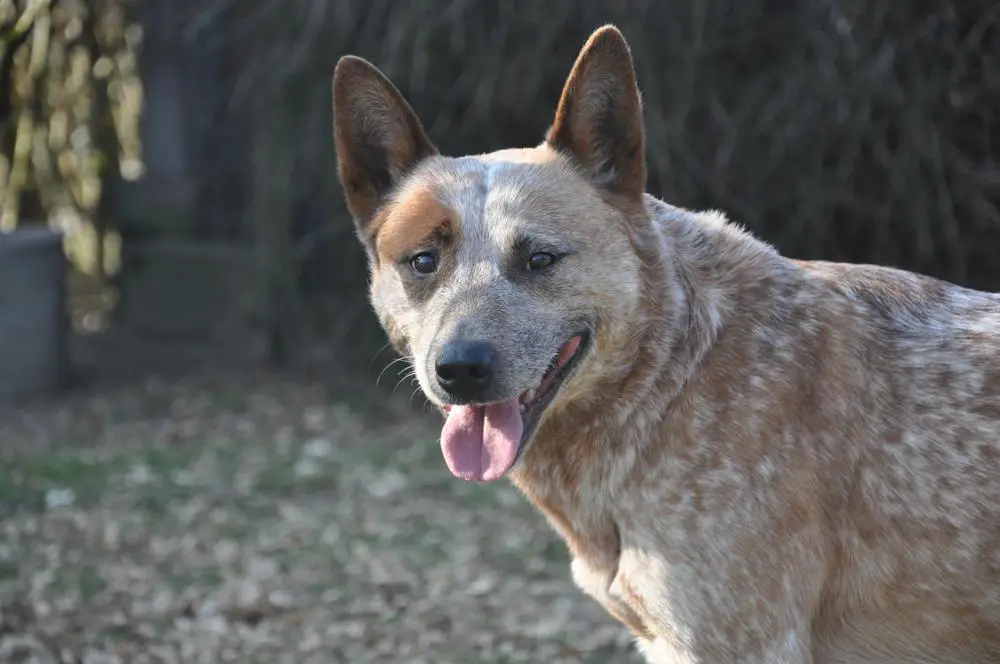
How Old is Your Australian Cattle Dog in Human Years
The table below shows your human years equivalent age of your Australian Cattle Dog. This table is based on a dog-to-human age study conducted by researchers from Purdue University.
Learn more about how old your Australian Cattle Dog is in human years here.
In 1997, researchers from Purdue University developed a method for converting a dog`s age to its human age. Their method was based on the 1953 work of the French Veterinarian, A. Lebeau that we discussed above.
Researchers from Purdue University took Lebeau`s work further by taking into account two important factors to develop a more accurate method for converting a dog`s age into its human equivalent age:
- The size of the dog: Smaller dog breeds live longer than larger breed dogs
- The lifespan of the dog: Dog breeds that live longer lives will age slower than dog breeds that live shorter lives
The average lifespan of the Australian Cattle Dog is 11.6 years.
Australian Cattle Dogs are medium-sized dogs. Australian Cattle Dogs weigh 30 to 50 pounds.
The method developed by the Purdue University veterinarian researchers took into account the lifespan and size of Australian Cattle Dog in converting Australian Cattle Dog age to human age.
The researchers used data on the lifespan and weight of 5,608 mixed breed dogs and 17,927 purebred dogs to develop their method for converting the ages of dogs (of different breed sizes and lifespans ) to their equivalent human ages.
The calculator below lets you convert your Australian Cattle Dog`s age to its human age based on the Purdue University method. Just enter your Australian Cattle Dog`s age in the calculator and it will compute your Australian Cattle Dog`s human age. If you do not know your Australian Cattle Dog`s exact age, enter an approximate age in the calculator.
Also, the table below shows how old your Australian Cattle Dog is in human years based on the method developed by the researchers.
Note that your Australian Cattle Dog`s human age changes day by day. Therefore, always check back to use the calculator to find your Australian Cattle Dog`s up-to-date human age.
Australian Cattle Dog Age to Human Age Calculator (Purdue Uni. Method)
Below is a Australian Cattle Dog age to human age calculator that is based on the methods developed by researchers from Purdue University.
The calculator will tell your Australian Cattle Dog`s human age based on your Australian Cattle Dog`s dog birthday. Also, the calculator will tell you which day is your Australian Cattle Dog`s human birthday! Try it out!
| Australian Cattle Dog Age (Years) | Human Age (Years) |
|---|---|
| 1 | 14 |
| 2 | 21 |
| 3 | 26 |
| 4 | 32 |
| 5 | 37 |
| 6 | 42 |
| 7 | 46 |
| 8 | 50 |
| 9 | 54 |
| 10 | 58 |
| 11 | 62 |
| 12 | 66 |
| 13 | 71 |
| 14 | 75 |
| 15 | 80 |
| 16 | 85 |
How Long Do Australian Cattle Dogs Live in Human Years?
The average lifespan of the Australian Cattle Dog is 11.6 years. In human years, the Australian Cattle Dog lives for 65 years.
How Old is 2-year-old Australian Cattle Dog in Human Years?
A 2-year old Australian Cattle Dog is 21 years old in human years.
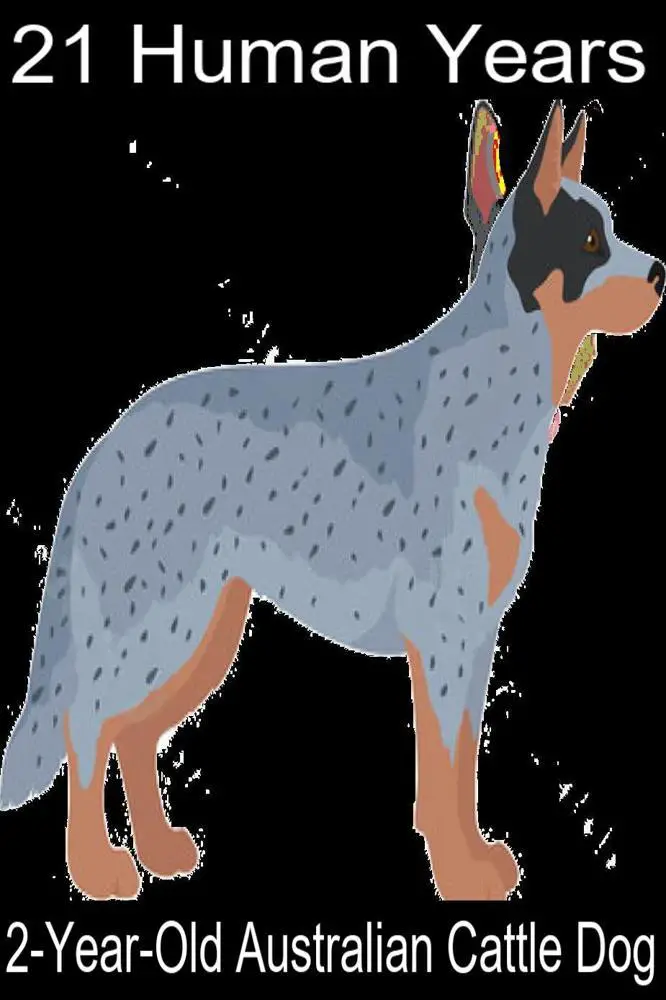
How Old is 7-year-old Australian Cattle Dog in Human Years?
A 7-year old Australian Cattle Dog is 46 years old in human years.
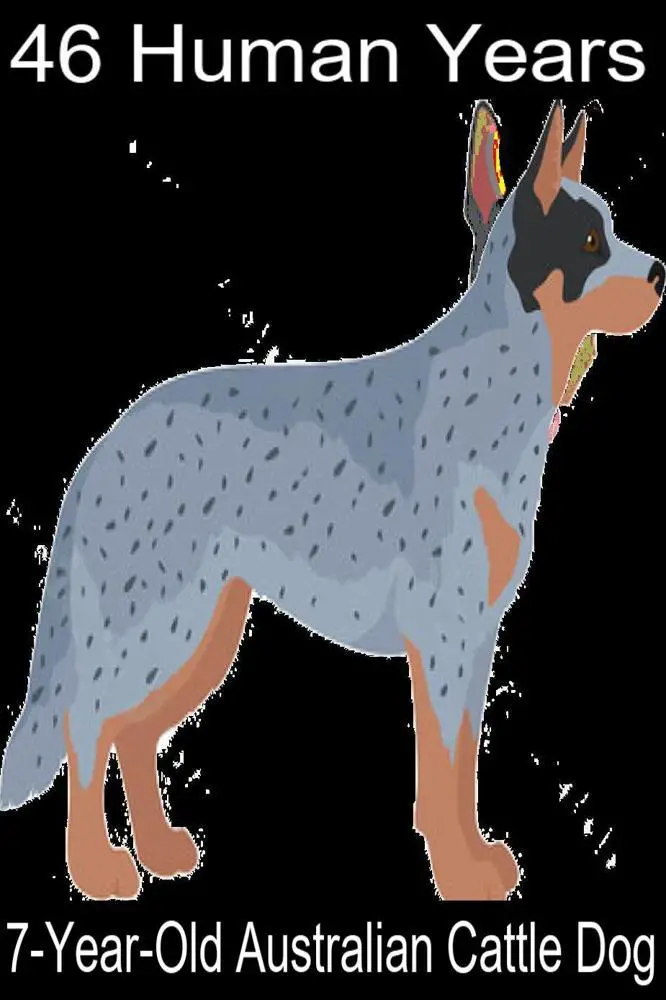
How Old is 9-year-old Australian Cattle Dog in Human Years?
A 9-year old Australian Cattle Dog is 54 years old in human years.
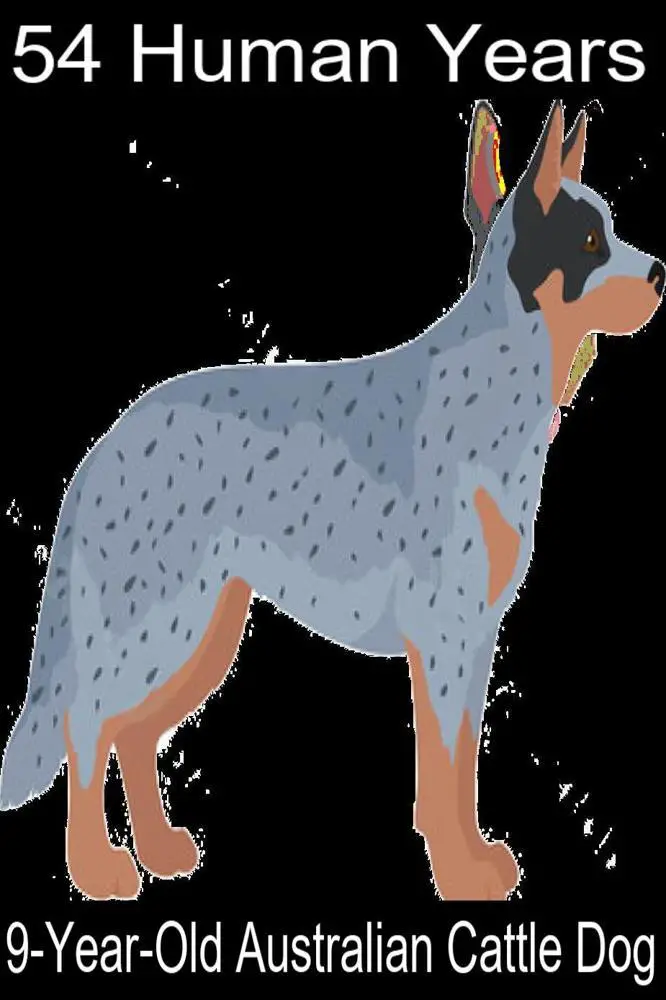
How Old is 10-year-old Australian Cattle Dog in Human Years?
A 10-year old Australian Cattle Dog is 58 years old in human years.
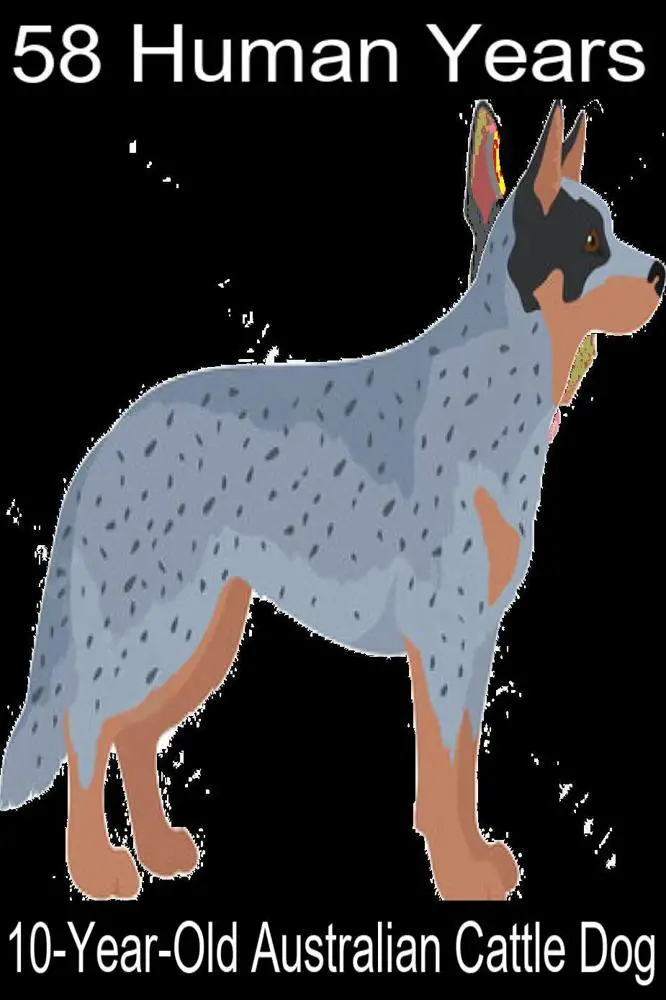
More Ways to Make Your Australian Cattle Dog Live Long
Here are more things your can do to make sure your Australian Cattle Dog live a long life:
-
Regular Exercise: Research studies have shown that one of the very effective ways to make a dog live long is to ensure that a dog is in good shape. Adequate exercise will make your Australian Cattle Dog fit and make it live longer.
-
Good Diet: A poorly-fed, underweight Australian Cattle Dog does not have a good chance of living a long life. Similarly, an overweight Australian Cattle Dog will have a shorter lifespan than a Australian Cattle Dog that is of normal weight. Therefore, it is important that your feed your Australian Cattle Dog high-quality dog food without overfeeding your Australian Cattle Dog. Check out our Australian Cattle Dog feeding guide here. Learn how you can prevent your Australian Cattle Dog from being overweight here.
-
Proper Hydration: Water is essential for your Australian Cattle Dog existence. Therefore, you should make sure your Australian Cattle Dog has access to clean water whenever your Australian Cattle Dog needs water. However, too much water is bad for your Australian Cattle Dog. See our Australian Cattle Dog water drinking guide to learn more on how to properly hydrate your Australian Cattle Dog.
-
Spaying/Neutering: Sterilizing your Australian Cattle Dog might prolong its life. Check out this guideline to know when it is the best time to spay/neuter your Australian Cattle Dog.
-
Routine Vet Care: Regular preventative visits to the vet can help catch diseases early.
-
Vaccinations: Always make sure your Australian Cattle Dog is up to date on its vaccination.
-
Dental Hygiene: Your Australian Cattle Dog’s teeth can get infected, and if the infection goes unnoticed, that infection can spread to other parts of the body and become systemic. This could lead to a shortened lifespan. You must have your Australian Cattle Dog teeth cleaned professionally at your vet’s office a couple of times in its lifetime. Talk with your vet about the best ages to have these cleanings done.
Conclusion on Australian Cattle Dog Life Expectancy
We hope the information we have provided will help your in increasing your Australian Cattle Dog`s life expectancy.
Tate Ackerman contributed to this article. Tate is a second-year veterinary student at Kansas State University. Tate is also a concurrent Ph.D. student. She has a lot of experience reading scientific literature and communicating that information to a non-veterinary audience. Tate was a veterinary technician for a companion animal practice before she applied to veterinary school.